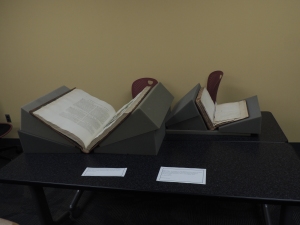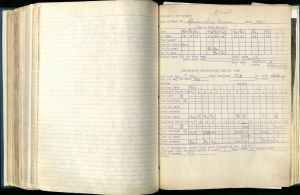Earth Day will officially be celebrated this Friday, April 22. Earth Day, which promotes an appreciation for the Earth’s environment and an awareness of environmental problems, was first celebrated April 22, 1970. The Special Collections Department holds a wide variety of collections related to environmental issues, conservation, and sustainability. Many of these are listed in our Environment and Sustainability Collections Guide and Natural History Collections Guide.
Soil conservation has been a concern in the past, just as it still is at the present time. You can find a variety of collections and publications here in Special Collections related to soil conservation since soil conservation is very much related to agriculture, one of our main collecting areas.

Above is an example of soil erosion the Soil Conservation Service (now the Natural Resources Conservation Service) tries to prevent – a buried tractor near Carlton, Colorado in 1953. The caption reads “This tractor and drill was used to plant wheat fields. Wheat has blown out and blown soil has difted around the machinery. Non-resident is farming the field and was not watching the land to protect it from blowing.” [from MS 460, Box 23, Folder 14]
We recently made available online the finding aid to the United States Soil Conservation Service Oral History Collection (MS 198). Douglas Helms, Historian for the Soil Conservation Service, conducted a series of oral history interviews in 1981. The interviewees were all long-time employees of the Soil Conservation Service. The collection consists of the interview transcripts, which contain a wonderful variety of memories and stories of these early pioneers of soil conservation here in the United States. For more information on this collection, please take a look at the collection’s online finding aid.
In addition to the oral history collection, another collection we hold related to soil conservation is that of the National Association of Conservation Districts (MS 460). The National Association of Conservation Districts (NACD) was formed in 1946 in order to provide national leadership to state and district conservation associations. Soil conservation districts had been set up nationwide beginning in 1937 and came from the desire to involve more farmers at the local level in soil and water conservation. The collection contains a wide variety of materials documenting the efforts of the NACD including reports, correspondence, meeting materials, publications, newsletters, speeches, bills and legislation related to conservation, speeches, and photographs. Included in the collection is correspondence and reports from at least one of the people from the oral history collection described above – Gordon Zimmerman.

One of many photographs (above) within the collection, this shows a once better than average farmstead in Baca County, Colorado which was abandoned during the dust storms of the 1930s. One of the many goals of the National Association of Conservation Districts is to prevent the year after year crop failures which occurred during the Dust Bowl. [from MS 460, Box 21, Folder 1]
Before and after photographs are included in the collection, showing land improvements due to conservation efforts:
 Philipsburg, Montana in 1880 [from MS 460, Box 23, Folder 14]
Philipsburg, Montana in 1880 [from MS 460, Box 23, Folder 14]

Philipsburg, Montana in 1880 [from MS 460, Box 23, Folder 14]
Despite the hard work of many organizations, soil erosion and other conservation issues are still a problem to this day. A recent report, Losing Ground, issued by the Environmental Working Group and based on studies by Iowa State University scientists, reports that farmland soil erosion in Iowa is much higher than government estimates. (For more on this report, visit the Environmental Working Group’s Losing Ground website).
And, finally, our department holds many, many collections related to conservation – including soil conservation both nationally and here in Iowa. These include the Hugh Hammond Bennett Papers (considered the father of soil conservation), Iowa Soil Conservation Districts Records, and Wallis R. Tonsfeldt Papers. If you would like to take a look at some of these, for Earth Day or any other time, please come visit us in Parks Library!

Gully caused by an eight inch rain on June 17, 1951 five miles southwest of Mapleton, Iowa. Notice the man standing in the Gully! [from the Wallis R. Tonsfeldt Papers, MS 558]

























 Frederic Leopold (at front of boat) with John Hale near Two Key Island (from Frederic Leopold Papers, MS 113, box 14).
Frederic Leopold (at front of boat) with John Hale near Two Key Island (from Frederic Leopold Papers, MS 113, box 14). A wood duck perched atop one of Frederic Leopold’s wood duck houses in 1965 (box 6, folder 7).
A wood duck perched atop one of Frederic Leopold’s wood duck houses in 1965 (box 6, folder 7). Leopold checking one of his wood duck houses in 1960 (box 6, folder 7).
Leopold checking one of his wood duck houses in 1960 (box 6, folder 7).

 Philipsburg, Montana in 1880 [from MS 460, Box 23, Folder 14]
Philipsburg, Montana in 1880 [from MS 460, Box 23, Folder 14]



